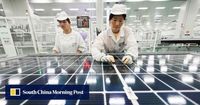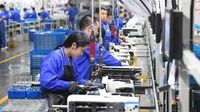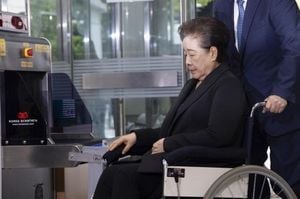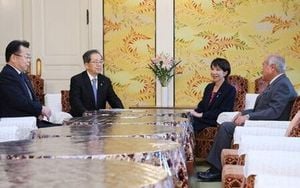China’s factory sector, once the world’s engine of industrial growth, is facing its toughest stretch in years. For the sixth consecutive month, official data show that Chinese manufacturing activity shrank in September 2025, marking the longest contraction streak since 2019. The National Bureau of Statistics reported a manufacturing purchasing managers’ index (PMI) of 49.8 for the month—up slightly from August’s 49.4, but still below the crucial 50-point threshold that separates growth from contraction.
This modest uptick offered a glimmer of hope, but it’s hardly cause for celebration. As Reuters put it, “the rebound reflects a seasonal uptick… but a continued upcycle is still some way off” given ongoing headwinds from sluggish domestic demand and global trade uncertainty. The PMI’s six-month losing streak is now the longest since the trade war era, and, as Bloomberg noted, “factories are still sputtering rather than surging.”
Yet, the picture isn’t entirely bleak. Digging into the details, the production sub-index jumped to 51.9—a six-month high—suggesting that some factories are ramping up output. New orders, though, remained weak at around 49.7. Large, state-backed enterprises focusing on domestic infrastructure and high-tech projects have generally fared better, while smaller, export-oriented firms are still struggling to keep their order books full.
Adding nuance, a private PMI survey by S&P Global’s “RatingDog” painted a somewhat rosier picture. This index, which leans more heavily on export-driven and private firms, climbed to 51.2 in September from 50.5 in August—signaling mild expansion. According to Reuters, this divergence reflects the different fortunes of China’s manufacturing giants versus its nimble exporters. As Stephen Innes of SPI Asset Management colorfully put it, “Factories are moving more goods, but they’re being forced to do it at thinner margins, like street vendors selling more bowls of noodles at half price just to keep the crowd coming.”
Still, the headline numbers mask a host of challenges. Domestic demand remains stubbornly soft, a hangover from the pandemic compounded by a prolonged property downturn and rising unemployment. Consumer prices fell 0.4% year-on-year in August—the fastest drop in six months—highlighting the ongoing risk of deflation. Producer prices, though improving, are still in negative territory, and ex-factory prices have now contracted for 16 straight months.
Trade, too, is a mixed bag. While exports to India, Africa, and Southeast Asia reached record levels in August, overall export growth remains limited by the persistent shadow of U.S. tariffs. The Trump-era duties—extended yet again until November—continue to squeeze Chinese manufacturers and their overseas buyers. According to Reuters, the U.S. still accounts for roughly 14% of China’s exports, so any breakthrough in Washington remains crucial.
There have been diplomatic overtures. On September 19, Presidents Xi Jinping and Donald Trump held a phone call that offered “glimmers of hope” for improved relations, as reported by Bloomberg. A face-to-face meeting is slated for late October in South Korea during the Asia-Pacific Economic Cooperation forum, and a truce on steep U.S. tariffs has been extended until November 10. Yet, as of now, no major breakthrough or tariff relief has materialized. Much hinges on a potential U.S. proposal to transfer ownership of TikTok to an American company, a deal that would require Beijing’s blessing.
Meanwhile, China’s services and construction sectors—measured by the non-manufacturing PMI—are treading water. The index slipped to 50.0 in September, the lowest level of the year and right at the expansion-contraction line. While telecom and banking remain bright spots, travel and catering have slowed following the busy summer season. As Zhiwei Zhang of Pinpoint Asset Management observed, “Economic momentum is weak in the third quarter,” though he noted that surprisingly resilient exports have helped offset some of the domestic drag.
Financially, the landscape is equally uneven. Industrial profits soared 20.4% year-on-year in August, a turnaround from July’s decline, buoyed in part by government efforts to crack down on cut-throat price wars in sectors like autos and solar. Yet, factory output and retail sales have posted their slowest growth in over a year, and consumer spending remains tepid despite government efforts to stimulate demand.
Policy response has been measured, if not exactly bold. In August, Beijing announced consumer loan subsidies to encourage spending, but has so far refrained from broad stimulus or aggressive interest rate cuts. The People’s Bank of China left key lending rates unchanged in September, even as the U.S. Federal Reserve moved to ease monetary policy. Policymakers argue that steady exports and a rallying stock market buy them time, but economists widely expect more action soon. Lynn Song of ING told Reuters that third-quarter data “suggest a strong case for further policy support,” forecasting another 10-basis-point rate cut and a 50-basis-point reserve requirement reduction before year-end.
All eyes are now on a key Politburo meeting set for October, where fresh growth plans may be unveiled. Many analysts believe authorities will tolerate some slowdown in late 2025, as long as the full-year GDP growth target of 5% isn’t threatened. Zhang Zhiwei told SCMP that policymakers “may step up support amid persistent external headwinds and weak domestic demand.” Central bank governor Pan Gongsheng has affirmed that a “range of monetary policy tools” remain available, though Beijing remains wary of over-stimulating credit or financial markets.
For now, the divergence between the official and private PMIs highlights the unevenness of China’s recovery. Large, domestically focused firms are holding up, while smaller exporters are seeing some improvement—but neither sector is firing on all cylinders. Xu Tianchen of the Economist Intelligence Unit warns that September’s uptick was partly seasonal, and that overall momentum is still “uneven, with a strong first quarter giving way to a soft midyear.”
Looking ahead, the challenges are clear. Overcapacity and deflationary pressures remain entrenched, as Capital Economics’ Zichun Huang cautions. Without a major pickup in consumer demand or a breakthrough on U.S. trade, the manufacturing contraction may linger. Even with a full resolution of trade tensions, it could take months for new orders to flow through to factory floors.
Still, there are reasons for cautious optimism. Export-oriented firms are showing resilience, and industrial profits have rebounded. The government has policy levers it can pull if needed, and the upcoming Politburo meeting may bring new measures. As one U.S. analyst summed up to Reuters, China’s factories are showing “a faint sign of stabilization”—but the recovery is far from certain without stronger demand at home and abroad.
In short, China’s manufacturing sector is at a crossroads. The coming months will test whether the world’s second-largest economy can reignite its growth engine—or whether it will remain stuck in the slow lane as 2025 draws to a close.





